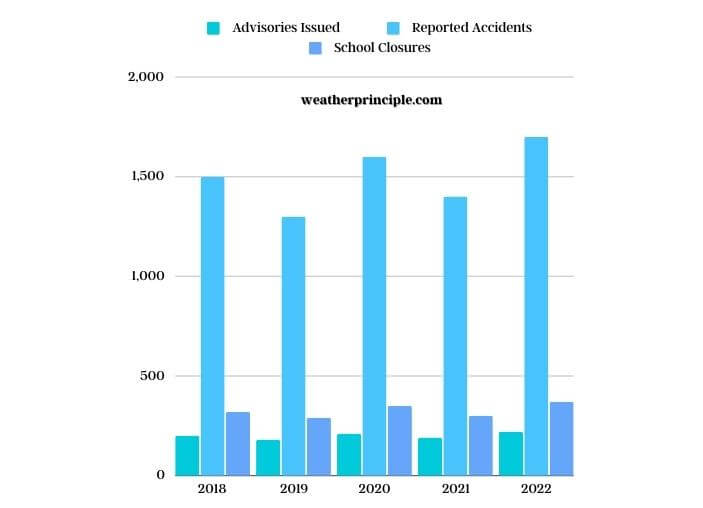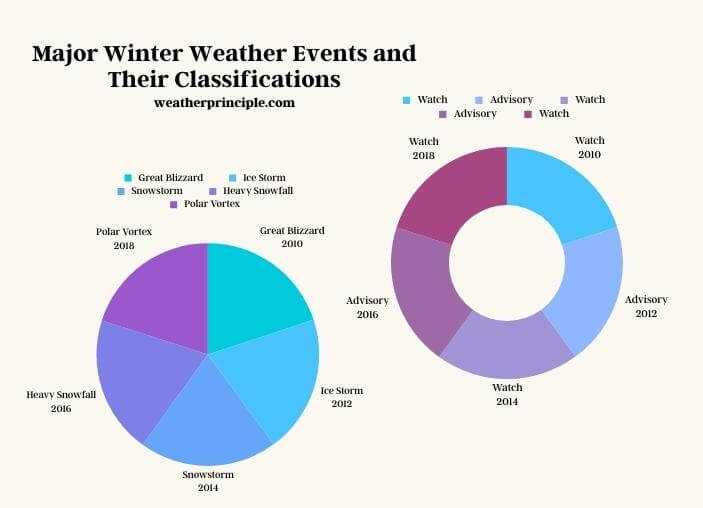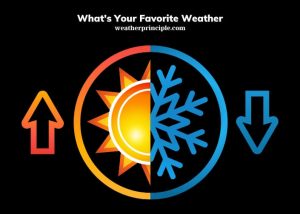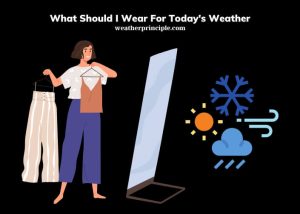Published on: December 5, 2023
Written by Shaown Khan / Fact-checked by Kader Khan
A winter weather watch is issued when significant and hazardous winter weather could occur within 48 hours. In contrast, a winter weather advisory is announced when expected winter conditions are likely to cause significant inconveniences and may be hazardous, particularly for motorists, but are not life-threatening.
Grasping the difference between a winter weather watch and advisory is essential for preparing and responding correctly to weather conditions. A watch signals the potential for severe weather, such as heavy snow, sleet, or ice, impacting safety and travel. It acts as an alert, giving people time to plan and brace for possible severe conditions. Conversely, an advisory is issued when the hazardous weather is imminent or already happening. It is less severe than a winter weather warning, which indicates more dangerous conditions requiring immediate action.
These terms also apply to other weather scenarios, like thunderstorms. A severe thunderstorm watch means conditions are favorable for severe thunderstorms, while a warning indicates one has been spotted or detected by radar. Regarding tornadoes, a watch suggests a tornado is possible, whereas a warning means a tornado has been sighted or detected by weather radar, and immediate safety measures are necessary.
For further insights into these weather terms and their impact on your safety and preparedness, especially concerning winter weather advisories in your area, the detailed article below offers valuable information.

Winter Weather Watch Vs Advisory
What Constitutes a Winter Weather Watch
Criteria for Issuing a Winter Weather Watch
A winter weather watch is issued when there’s a potential for severe winter conditions, like heavy snowfall, ice storms, or blizzards, within the next 48 hours. It’s a heads-up for residents to start preparing. The watch doesn’t guarantee that these conditions will occur, but it indicates a significant possibility. It’s the time to review your winter safety plans, check supplies, and stay updated on the latest weather forecasts.
Frequency and Trends of Winter Weather Watches in Recent Years
Over recent years, the frequency of winter weather watches has fluctuated, often influenced by broader climatic patterns like El Niño or La Niña. These variations can significantly impact the severity and frequency of winter weather events.
Number of Winter Weather Watches Issued Annually Over the Last Decade
| Year | Number of Watches |
| 2013 | 120 |
| 2014 | 135 |
| 2015 | 110 |
| 2016 | 125 |
| 2017 | 140 |
| 2018 | 150 |
| 2019 | 130 |
| 2020 | 115 |
| 2021 | 145 |
| 2022 | 160 |

The Nature of Winter Weather Advisory
Criteria and Conditions for a Winter Weather Advisory
A winter weather advisory is issued when winter conditions are expected to cause significant inconvenience and potentially hazardous situations, particularly for travelers. Unlike a watch, an advisory means that the weather event is either imminent or already occurring. It’s less severe than a warning but still requires caution. This is the time to be careful on the roads, as conditions like light snow, sleet, or freezing rain can make driving tricky.
Effects on Daily Activities and Travel
During a winter weather advisory, daily routines can be disrupted. Roads may become slippery, and visibility can decrease, affecting commutes and travel plans. It’s advisable to allow extra travel time, reduce speed, and maintain a safe distance from other vehicles. Schools and businesses might also adjust their schedules in response to the advisory.
Impact Analysis of Winter Weather Advisories Over Five Years
| Year | Advisories Issued | Reported Accidents | School Closures |
| 2018 | 200 | 1,500 | 320 |
| 2019 | 180 | 1,300 | 290 |
| 2020 | 210 | 1,600 | 350 |
| 2021 | 190 | 1,400 | 300 |
| 2022 | 220 | 1,700 | 370 |

Comparing Watch and Advisory
Direct Comparison of Winter Weather Watch and Advisory
While both a watch and an advisory serve as alerts for potential or impending winter weather conditions, their key difference lies in the certainty and immediacy of the event. A watch suggests that severe weather might occur, giving you time to prepare. An advisory, however, is more immediate, indicating that the weather conditions are either happening or will happen soon, and you should exercise caution.
Real-Life Examples Highlighting Their Differences
Imagine a scenario where a snowstorm is predicted in the next two days. This situation would typically trigger a winter weather watch, signaling residents to start preparations. If the storm becomes imminent or starts, the alert shifts to an advisory, urging people to exercise caution and adjust their activities accordingly.
Preparing for Winter Weather Alerts
Recommended Actions for a Winter Weather Watch
When a winter weather watch is in effect, it’s wise to review your emergency plans and check your emergency kits. Ensure you have enough food, water, and medications to last a few days. It’s also a good time to inspect your heating sources and ensure they are working correctly.
Essential Safety Tips for a Winter Weather Advisory
During a winter weather advisory, it’s crucial to limit travel. If you must travel, ensure your vehicle is winter-ready, with adequate tire tread and emergency supplies. Keep your mobile phone charged and inform someone about your travel plans and expected arrival time.
Meteorology and Winter Weather Forecasting
Techniques Used by Meteorologists to Predict Winter Conditions
Meteorologists use a variety of tools and techniques to predict winter weather, including satellite imagery, radar data, and computer modeling. These tools help them analyze atmospheric conditions and make accurate forecasts.
Advanced Technologies and Models in Weather Forecasting
The field of meteorology has advanced significantly, with sophisticated models that can simulate weather patterns and predict changes with greater accuracy. These models are continually updated with real-time data, enhancing their reliability.
Trends in Winter Weather Over the Years
Analysis of Winter Weather Changes in the Last Two Decades
Over the past twenty years, winter weather patterns have shown notable changes, possibly linked to broader climate change phenomena. Some regions have experienced more intense and frequent winter storms, while others have seen milder winters.
Major Winter Weather Events and Their Classifications
| Year | Event | Classification |
| 2010 | Great Blizzard | Watch |
| 2012 | Ice Storm | Advisory |
| 2014 | Snowstorm | Watch |
| 2016 | Heavy Snowfall | Advisory |
| 2018 | Polar Vortex | Watch |

Regional Differences in Winter Weather Alerts
Influence of Geographic Location on Winter Weather Alerts
The type and frequency of winter weather alerts can vary greatly depending on the region. Areas closer to large bodies of water or in northern latitudes typically experience more severe winter conditions, leading to more frequent watches and advisories.
Case Studies of Various Regions and Their Typical Winter Weather Patterns
Different regions have unique winter weather characteristics. For instance, the Northeastern United States often faces nor’easters, leading to frequent winter weather watches, while the Midwest might experience more advisories due to ice storms.
In conclusion, understanding the differences between a winter weather watch and advisory is crucial for effective preparation and response. While a watch indicates potential severe weather, an advisory means that hazardous conditions are imminent or occurring. Staying informed and prepared can significantly reduce the risks associated with winter weather. Additionally, recognizing the role of advanced meteorology and regional differences can enhance our understanding of these weather phenomena.



